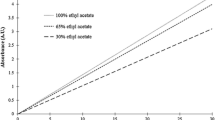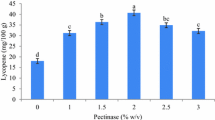Abstract
The objective of this research is to examine various methods of lycopene extraction, taking into consideration their economic and environmental implications. The methods under investigation include solvent-assisted extraction (SAE), supercritical fluid extraction (SCF), enzyme-assisted extraction (EAE), ultrasound-assisted extraction (UAE), and integrated ultrasound surfactant–assisted extraction (IUSAE). The techno-economic assessment of various lycopene extraction methods revealed that IUSAE surpasses other methods in terms of economic viability, with a net present value (NPV) of 20,858 $ and a payback period of 4.2 years. Sensitivity analysis using Monte Carlo simulation was also conducted to further evaluate the robustness of the process. Additionally, life cycle assessment (LCA) demonstrated that IUSAE has the least environmental impact compared to other methods. Furthermore, the environmental impact of transitioning from a mixed-grid energy source to renewable energy was assessed. It was observed that using wind energy as a source of power for different unit operations resulted in a significant reduction of 78–90% in midpoint indicators such as global warming potential, acidification potential, photochemical oxidation, eutrophication, and human toxicity. This hig
hlights the positive environmental benefits of utilizing renewable energy in the lycopene extraction process.





Similar content being viewed by others
Data availability
The dataset generated during and/or analyzed during the current study are available from the corresponding author on reasonable request.
Abbreviations
- μL:
-
microlitre
- COL:
-
labor of cost
- COM:
-
cost of manufacturing
- CRM:
-
cost raw material
- CUL:
-
cost of utility
- P:
-
particulate handling
- Nnp:
-
non particulate handling
- DFC:
-
direct fixed capital cost
- IFC:
-
indirect fixed capital cost
- OC:
-
other cost
- FCI:
-
total fixed capital investment
- TCI:
-
total capital investment
- Eqs:
-
equation
- g/g:
-
gram/gram
- g:
-
gram
- h:
-
hour
- kWh:
-
kilo watt hour
- MC:
-
Monte Carlo
- mg :
-
milligram
- mL:
-
milliliter
- mM:
-
milimolar
- nm:
-
nanometer
- NPV:
-
net present value
- PB:
-
payback period
- PEO-PPO-PEO:
-
polyethylene oxide polypropylene oxide polyethylene oxide
- ROR:
-
rate of return
- Rpm:
-
revolution per minute
- (v/v):
-
volume per volume
- AC:
-
acidification potential
- EU:
-
eutrophication potential
- GWP:
-
global warming potential
- PO:
-
photochemical ozone creation potential
- HT:
-
human toxicity
- SAE:
-
solvent-assisted extraction
- SCF:
-
supercritical fluid extraction
- EAE:
-
enzyme-assisted extraction
- UAE:
-
ultrasound-assisted extraction
- IUSAE:
-
integrated ultrasound surfactant–assisted extraction
References
Negi S, Anand N (2016) Factors leading to losses and wastage in the supply chain of fruits and vegetables sector in India. Unpublished. https://doi.org/10.13140/RG.2.1.2395.5607
Colle I, Lemmens L, Van Buggenhout S et al (2010) Effect of thermal processing on the degradation, isomerization, and bioaccessibility of lycopene in tomato pulp. J Food Sci 75:753–759. https://doi.org/10.1111/j.1750-3841.2010.01862.x
Jha SN, Vishwakarma RK, Ahmad T et al (2016) Report on assessment of quantitative harvest and post-harvest losses of major crops/commodities in india sponsor: ministry of Food processing industries. Icar-Ciphet 130. https://doi.org/10.13140/RG.2.1.3024.3924
Gheonea Dima I, Aprodu I, Cîrciumaru A et al (2020) Microencapsulation of lycopene from tomatoes peels by complex coacervation and freeze-drying: evidences on phytochemical profile, stability and food applications. J Food Eng 288. https://doi.org/10.1016/j.jfoodeng.2020.110166
Méndez-Carmona JY, Ascacio-Valdes JA, Alvarez-Perez OB et al (2022) Tomato waste as a bioresource for lycopene extraction using emerging technologies. Food Biosci 49. https://doi.org/10.1016/j.fbio.2022.101966
Peira G, Bollani L, Giachino C, Bonadonna A (2018) The management of unsold food in outdoor market areas: food operators’ behaviour and attitudes. Sustain 10:1–16. https://doi.org/10.3390/su10041180
McKenzie T (2017) Almost 90% of edible tomatoes thrown away based on appearance – research | Food waste | The Guardian. Guard. news website year 1
Page G, Ridoutt B, Bellotti B (2012) Carbon and water footprint tradeoffs in fresh tomato production. J Clean Prod 32:219–226. https://doi.org/10.1016/j.jclepro.2012.03.036
FAO publications catalogue (2021) FAO publications catalogue. In: FAO Publ Cat, vol 2021
Benucci I, Lombardelli C, Mazzocchi C, Esti M (2022) Natural colorants from vegetable food waste: Recovery, regulatory aspects, and stability—a review. Compr Rev Food Sci Food Saf 21:2715–2737. https://doi.org/10.1111/1541-4337.12951
Zuorro A, Fidaleo M, Lavecchia R (2011) Enzyme-assisted extraction of lycopene from tomato processing waste. Enzyme Microb Technol 49:567–573. https://doi.org/10.1016/j.enzmictec.2011.04.020
Garnett T (2011) Where are the best opportunities for reducing greenhouse gas emissions in the food system (including the food chain)? Food Policy 36:S23–S32. https://doi.org/10.1016/j.foodpol.2010.10.010
Poojary MM, Passamonti P (2015) Extraction of lycopene from tomato processing waste: Kinetics and modelling. Food Chem 173:943–950
Subramanian R (2016) India processing tomato segment current status, trends and opportunities for engagement. India Green Innov Cent Agri-Food Sect 16:28
Bhatkar NS, Shirkole SS, Mujumdar AS, Thorat BN (2021) Drying of tomatoes and tomato processing waste: a critical review of the quality aspects. Dry Technol 39:1720–1744. https://doi.org/10.1080/07373937.2021.1910832
Ubeyitogullari A, Ciftci ON (2022) Enhancing the bioaccessibility of lycopene from tomato processing byproducts via supercritical carbon dioxide extraction. Curr Res Food Sci 5:553–563. https://doi.org/10.1016/j.crfs.2022.01.020
Global Lycopene Market to Reach $185.3 Million by 2027. https://www.globenewswire.com/news-release/2023/01/04/2583026/0/en/Global-Lycopene-Market-to-Reach-185-3-Million-by-2027.html. Accessed 06-01-2023
Rao AV, Agarwal S (1999) Role of lycopene as antioxidant carotenoid in the prevention of chronic diseases: a review. Nutr Res 19:305–323. https://doi.org/10.1016/S0271-5317(98)00193-6
Rao AV, Agarwal S (2000) Role of antioxidant lycopene in cancer and heart disease. J Am Coll Nutr 19:563–569. https://doi.org/10.1080/07315724.2000.10718953
Zuorro A (2020) Enhanced lycopene extraction from tomato peels by optimized mixed-polarity solvent mixtures. Molecules 25. https://doi.org/10.3390/molecules25092038
Ollanketo M, Hartonen K, Riekkola ML et al (2001) Supercritical carbon dioxide extraction of lycopene in tomato skins. Eur Food Res Technol 212:561–565. https://doi.org/10.1007/s002170100298
Zuorro A, Lavecchia R (2010) Mild enzymatic method for the extraction of lycopene from tomato paste. Biotechnol Biotechnol Equip 24:1854–1857. https://doi.org/10.2478/V10133-010-0028-0
Lombardelli C, Benucci I, Mazzocchi C, Esti M (2022) Green enzymatic recovery of functional bioactive compounds from unsold vegetables: storability and potential health benefits. Appl Sci 12. https://doi.org/10.3390/app122312249
Kumcuoglu S, Yilmaz T, Tavman S (2014) Ultrasound assisted extraction of lycopene from tomato processing wastes. J Food Sci Technol 51:4102–4107. https://doi.org/10.1007/s13197-013-0926-x
Amiri-Rigi A, Abbasi S (2016) Microemulsion-based lycopene extraction: effect of surfactants, co-surfactants and pretreatments. Food Chem 197:1002–1007. https://doi.org/10.1016/j.foodchem.2015.11.077
Ashraf W, Latif A, Lianfu Z et al (2022) Technological advancement in the processing of lycopene: a review. Food Rev Int 38:857–883. https://doi.org/10.1080/87559129.2020.1749653
Saini RK, Keum YS (2018) Carotenoid extraction methods: a review of recent developments. Food Chem 240:90–103. https://doi.org/10.1016/j.foodchem.2017.07.099
Deng Y, Zhao S, Yang X et al (2021) Evaluation of extraction technologies of lycopene: hindrance of extraction, effects on isomerization and comparative analysis - a review. Trends Food Sci Technol 115:285–296. https://doi.org/10.1016/j.tifs.2021.06.051
Yadav RD, Khare T, Dhamole PB (2023) Process development and techno-economic assessment of lycopene extraction from tomatoes using surfactant. Biomass Convers Biorefin. https://doi.org/10.1007/s13399-023-04080-5
McLain VC (2008) Safety assessment of poloxamers 101, 105, 108, 122, 123, 124, 181, 182, 183, 184, 185, 188, 212, 215, 217, 231, 234, 235, 237, 238, 282, 284, 288, 331, 333, 334, 335, 338, 401, 402, 403, and 407, poloxamer 105 benzoate, and poloxamer 182 dibenzoate as use. Int J Toxicol 27:93–128. https://doi.org/10.1080/10915810802244595
Raut S, Jain S, Dhamole P, Agrawal S (2022) WPC manufacturing using thermal -polyelectrolyte precipitation: a product quality and techno-economic assessment. J Food Eng 315:110796. https://doi.org/10.1016/j.jfoodeng.2021.110796
Khanpit VV, Tajane SP, Mandavgane SA (2023) Technoeconomic and life cycle analysis of soluble dietary fiber concentrate production from waste orange peels. Waste Manag 155:29–39. https://doi.org/10.1016/j.wasman.2022.10.036
Delhi N, Practices B, Takeaways K (2018) Table 11: selective examples of successful discom performance improvement. 51–60
Thoresen M, Malgas S, Pletschke BI (2022) Enzyme adsorption-desorption and evaluation of various cellulase recycling strategies for steam pre-treated Eucalyptus enzymatic degradation. Biomass Convers Biorefin 12:265–274. https://doi.org/10.1007/s13399-020-00670-9
Lü L, Zhu L, Liu H et al (2018) Comparison of continuous homogenous azeotropic and pressure-swing distillation for a minimum azeotropic system ethyl acetate/n-hexane separation. Chinese J Chem Eng 26:2023–2033. https://doi.org/10.1016/j.cjche.2018.02.002
Pataro G, Carullo D, Falcone M, Ferrari G (2020) Recovery of lycopene from industrially derived tomato processing by-products by pulsed electric fields-assisted extraction. Innov Food Sci Emerg Technol 63:102369. https://doi.org/10.1016/j.ifset.2020.102369
Lycopene analytical standard 502-65-8. https://www.sigmaaldrich.com/IN/en/product/sial/75051?gclid=Cj0KCQiA5NSdBhDfARIsALzs2EDs43feQoDBUwsFZx-jWSPUsq05WnybXiUEU2yyEMEcMzSU2QJonSwaAj2UEALw_wcB&gclsrc=aw.ds. Accessed 05-01-2023
Khanna N, Wadhwa J, Pitroda A et al (2022) Life cycle assessment of environmentally friendly initiatives for sustainable machining: a short review of current knowledge and a case study. Sustain Mater Technol 32:e00413. https://doi.org/10.1016/j.susmat.2022.e00413
Banerjee S, Munagala M, Shastri Y et al (2022) Process design and techno-economic feasibility analysis of an integrated pineapple processing waste biorefinery. ACS Eng Au 2:208–218. https://doi.org/10.1021/ACSENGINEERINGAU.1C00028
Patel M, Zhang X, Kumar A (2016) Techno-economic and life cycle assessment on lignocellulosic biomass thermochemical conversion technologies: a review. Renew Sustain Energy Rev 53:1486–1499. https://doi.org/10.1016/j.rser.2015.09.070
Morelli B, Hawkins TR, Niblick B et al (2018) Critical review of eutrophication models for life cycle assessment. Environ Sci Technol 52:9562–9578. https://doi.org/10.1021/acs.est.8b00967
Carvalho GC, de Camargo BA, de Araújo JT, Chorilli M (2021) Lycopene: from tomato to its nutraceutical use and its association with nanotechnology. Trends Food Sci Technol 1(118):447–458
Acknowledgements
The authors would like to thank Badische Anilin und Soda Fabrik (BASF) for providing the free samples of surfactant.
Author information
Authors and Affiliations
Contributions
Rajendra D. Yadav: conceptualization, investigation, methodology, formal analysis, writing original draft, writing—reviewing and editing. Pradip B. Dhamole: writing—reviewing and editing, investigation, supervision, resources.
Corresponding author
Ethics declarations
Ethics approval
Not applicable
Competing interests
The authors declare no competing interests.
Additional information
Publisher’s note
Springer Nature remains neutral with regard to jurisdictional claims in published maps and institutional affiliations.
Supplementary information
Rights and permissions
Springer Nature or its licensor (e.g. a society or other partner) holds exclusive rights to this article under a publishing agreement with the author(s) or other rightsholder(s); author self-archiving of the accepted manuscript version of this article is solely governed by the terms of such publishing agreement and applicable law.
About this article
Cite this article
Yadav, R.D., Dhamole, P.B. Techno economic and life cycle assessment of lycopene production from tomato peels using different extraction methods. Biomass Conv. Bioref. (2023). https://doi.org/10.1007/s13399-023-04676-x
Received:
Revised:
Accepted:
Published:
DOI: https://doi.org/10.1007/s13399-023-04676-x




